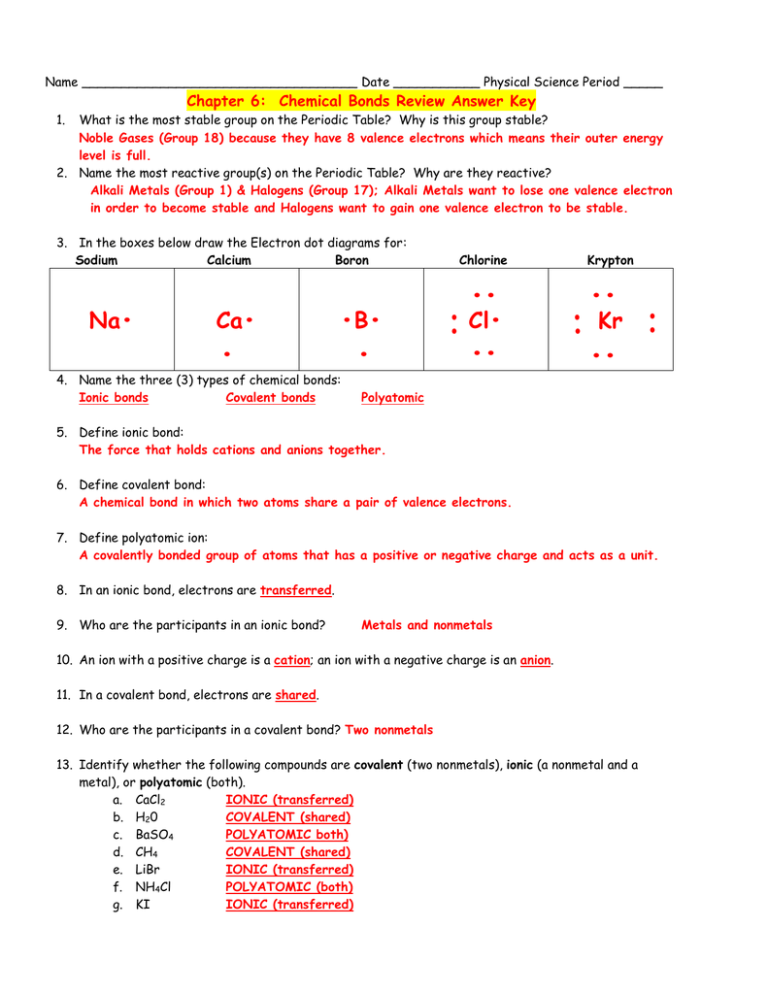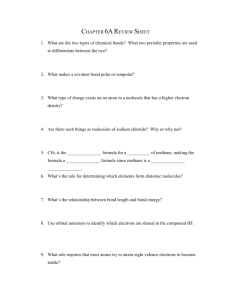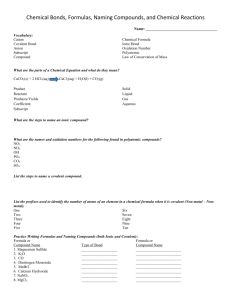Name
advertisement

Name ___________________________________ Date ___________ Physical Science Period _____ Chapter 6: Chemical Bonds Review Answer Key 1. What is the most stable group on the Periodic Table? Why is this group stable? Noble Gases (Group 18) because they have 8 valence electrons which means their outer energy level is full. 2. Name the most reactive group(s) on the Periodic Table? Why are they reactive? Alkali Metals (Group 1) & Halogens (Group 17); Alkali Metals want to lose one valence electron in order to become stable and Halogens want to gain one valence electron to be stable. •B• • 4. Name the three (3) types of chemical bonds: Ionic bonds Covalent bonds • •• Kr •• Ca• •• Cl• •• Krypton •• Na• Chlorine •• 3. In the boxes below draw the Electron dot diagrams for: Sodium Calcium Boron •• Polyatomic 5. Define ionic bond: The force that holds cations and anions together. 6. Define covalent bond: A chemical bond in which two atoms share a pair of valence electrons. 7. Define polyatomic ion: A covalently bonded group of atoms that has a positive or negative charge and acts as a unit. 8. In an ionic bond, electrons are transferred. 9. Who are the participants in an ionic bond? Metals and nonmetals 10. An ion with a positive charge is a cation; an ion with a negative charge is an anion. 11. In a covalent bond, electrons are shared. 12. Who are the participants in a covalent bond? Two nonmetals 13. Identify whether the following compounds are covalent (two nonmetals), ionic (a nonmetal and a metal), or polyatomic (both). a. CaCl2 IONIC (transferred) b. H20 COVALENT (shared) c. BaSO4 POLYATOMIC both) d. CH4 COVALENT (shared) e. LiBr IONIC (transferred) f. NH4Cl POLYATOMIC (both) g. KI IONIC (transferred) 14. Fill in the missing spaces in the chart below: Number Prefix Number Prefix 1 mono 6 hexa 2 di 7 hepta 3 tri 8 octa 4 tetra 9 nona 5 penta 10 deca *** When writing the names of covalent compounds, you must use prefixes.*** *** When writing the names of ionic compounds, you do NOT use prefixes.*** *** Polyatomic ions follow the rules for ionic naming.*** 15. Complete the oxidation chart below. Group # 1 2 13 14 15 16 17 18 Valence e- 1 2 3 4 5 6 7 8 Oxidation # 1- 2- 3- +/-4 3- 2- 1- 0 16. Write the formulas for the following ionic compounds using the Criss-Cross method. Chemical Name Ions Chemical Formula K Potassium fluoride +1 ,F -1 KF Magesium nitride Mg +2 , N -3 Mg3N2 Barium oxide Ba +2 , O -2 BaO Al Aluminum phosphate +3 , PO4 -3 17. Mixed practice. Write the chemical formulas for the following compounds: a. Carbon dioxide CO2 b. Diphosphorus pentachloride c. Nitrogen monoxide d. Cesium sulfide e. Beryllium oxide f. Sulfur hexachloride P2Cl5 N0 Cs2S BeO SF6 18. Mixed practice. Write the chemical name for the following compounds: CCl4 Carbon tetrachloride PBr3 Phosphorus tribromide N2O3 Dinitrogen trioxide H 20 Dihydrogen monoxide Al (PO4)






